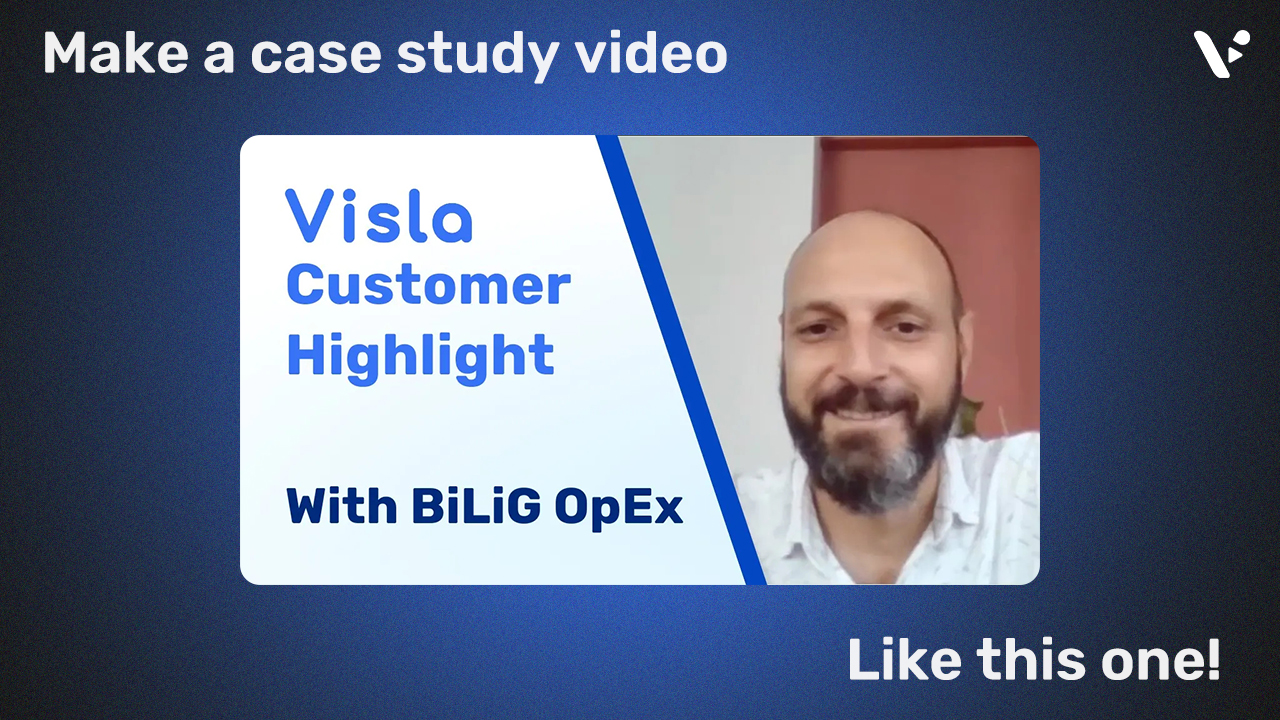If you’re looking to create a case study video, Visla’s text-to-video tool could be the easiest route from concept to polished content. Whether you’re in marketing, sales, training, or education, a case study video can be one of the most persuasive ways to show your audience the real-world impact of your product or service.
How to make a case study video with Visla
Creating a case study video with Visla is incredibly simple. With just four steps, you’ll have a draft video ready. Don’t believe it’s that easy? Try it out.
1. In Visla, click on the “Create Video” button.
Start by clicking this button to begin your video project.


2. Click on the “Text” option.
This page lets you copy and paste your case study content into the text box provided. For those who want some polish on their content, just check the box to have Visla’s AI rewrite it into a proper video script.
3. Click on “Generate Video.”
After entering your text, hit “Generate Video,” and Visla’s AI will create a draft video.


4. Refine your video in the scene-based editor.
Once your draft is generated, you can customize it with advanced edits in Visla’s scene-based editor. Rearrange scenes, add transitions, adjust background music, or change b-roll footage to suit your brand and tone.
Creating a case study video with Visla’s text-to-video feature is fast, but if you want to add unique touches, the editing options are right there for you.
What makes a good case study video?
A case study video is a visual story about how a customer used a product or service to solve a real problem. It’s not just about featuring your business—it’s about showing your audience the measurable impact of what you offer. Here’s a structure you can use:
- Introduce your customer and the problem they faced.
Describe your customer briefly, focusing on their unique situation. This should set up the “problem” part of the story. You want viewers to understand the challenge your customer faced, making them more invested in how the story unfolds. - Present your product as the solution.
Show how your product or service solved the customer’s problem. This part should emphasize key benefits and practical applications rather than just product features. Keep it relatable and grounded. - Share specific, measurable results.
The best case studies are backed by real data, so be sure to include quantifiable results or specific outcomes. This could be time saved, cost reduced, or even customer growth. Data makes the success story credible and memorable.
A clear, structured story makes it easy for viewers to follow along and leaves a lasting impression. This simple approach has shown to resonate with audiences; for example, HubSpot reports that 54% of people want to see more video content from brands they support, particularly content with clear, valuable insights.
Why case studies make amazing videos
A well-made case study video can serve multiple business purposes. They are versatile assets, ideal for sharing in presentations, emails, or social media, and they work well in every department—from marketing to sales and even customer success. But what makes them such a powerful tool?
- They demonstrate real-world success.
Case studies provide actual examples of how a product or service made a difference, making them far more persuasive than abstract promises. People trust real stories, especially when backed by data, like the 85% of consumers who trust online customer reviews and case studies. Sharing real success stories builds trust. - They are relatable and engaging.
Seeing a relatable person in a real-life scenario allows your audience to imagine themselves in a similar situation, facing similar challenges. In a short amount of time, you can capture attention, generate empathy, and leave a lasting impact. - They support multiple business goals.
A case study video is a multi-purpose asset. Use it to boost sales by showing prospects the value of your product. Use it for training by showing team members how to communicate real-life benefits. Or use it in marketing campaigns to boost awareness. No matter the purpose, a single case study video can yield value across the business.
FAQ
How long should a case study video be?
The ideal length for a case study video is typically between 1 to 3 minutes. Videos under three minutes are more likely to capture and retain viewer attention, allowing you to deliver your message concisely. Shorter videos (1-2 minutes) work well for social media and initial outreach, where quick engagement is key. However, if you need to cover more detailed information or complex results, a 3-minute video is ideal for providing a deeper narrative without losing the audience’s interest. According to video marketing studies, the two-minute mark is a sweet spot for maintaining viewer engagement.
What is the best format for a case study video?
A compelling case study video follows a structured, story-based format that typically includes three main sections: introduction, solution, and results. Start with a brief introduction to the client and their challenge. Next, highlight how your product or service provided a solution. Finally, showcase the measurable results or outcomes the client achieved. Many effective case study videos also incorporate customer testimonials, data visuals, and B-roll footage to illustrate key points. This format keeps the story clear and relatable, allowing viewers to quickly understand the value of your offering in a real-world scenario.
What is the point of a case study video?
The main purpose of a case study video is to demonstrate real-life success with your product or service by showcasing how a customer solved a problem using your solution. Case study videos build trust with potential clients by showing tangible, credible results and allow viewers to envision similar outcomes for themselves. As a versatile asset, they support marketing, sales, and educational efforts by providing evidence-based stories that resonate with viewers, making case study videos one of the most effective ways to convey a brand’s impact and credibility.

